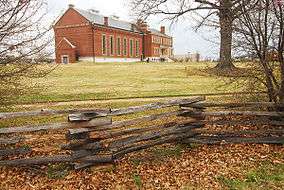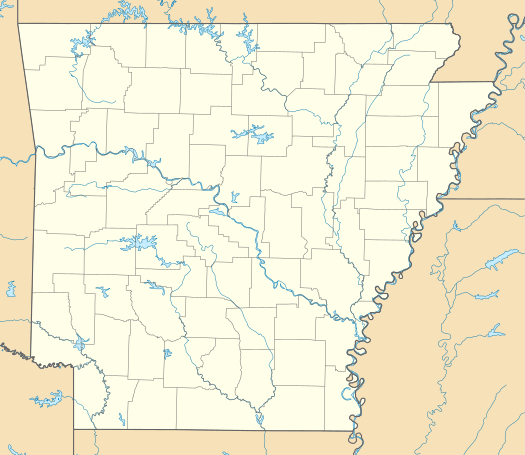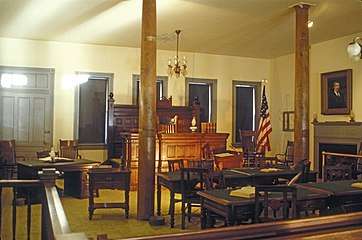Fort Smith National Historic Site
Fort Smith National Historic Site is a National Historic Site located in Fort Smith, Arkansas, along the Arkansas River. The first fort at this site was established by the United States in 1817, before this area was established as part of Indian Territory. It was later replaced and the second fort was operated by the US until 1871. This site was designated as a National Historic Landmark in 1961.
| Fort Smith National Historic Site | |
|---|---|
 Fort Smith National Historic Site in 2009 | |
  | |
| Location | Sebastian County, Arkansas |
| Nearest city | Fort Smith, Arkansas |
| Coordinates | 35°23′18″N 94°25′47″W |
| Area | 75 acres (30 ha) |
| Established | September 13, 1961 |
| Visitors | 86,122 (in 2011) |
| Governing body | National Park Service |
| Website | Fort Smith National Historic Site |
| Designated | October 15, 1966 |
| Reference no. | 66000202[1] |
| Designated | December 19, 1960 |
The fort was the first site of the United States District Court for the Western District of Arkansas, which had jurisdiction over western Arkansas and all of Indian Territory. It began operations in 1875 with the appointment of Isaac C. Parker as the first federal district judge here. The town of Fort Smith, Arkansas developed around the fort.
Description

The site includes the second historic fort constructed at this place. In addition, located on the grounds are the foundation remains of the first Fort Smith (1817–1824), the commissary building (c. 1838) and a reconstruction of the gallows used by the federal court. A walking trail along the Arkansas River includes wayside exhibits on the Trail of Tears.
Congress authorized acquisition of land on the Oklahoma bank of the Arkansas River to be included in the National Historic Site, in order to preserve a historic viewshed, but it has not been acquired.[2]
The park visitor center is now located in the old Barracks/Courthouse/Jail building. Exhibits in the visitor center focus on Fort Smith's military history from 1817–1871, its role in the western expansion of the United States, Federal District Judge Isaac Parker and the federal court's effects on justice in Indian Territory, the U.S. Deputy Marshals and outlaws, Federal Indian policy, and Indian Removal, including the Cherokee Trail of Tears.
History
The site was established in 1961 in order to protect the remains of two 19th-century U.S. military forts, including a building that once housed the United States District Court for the Western District of Arkansas, which had jurisdiction over federal cases in Indian Territory. Fort Smith was also notable as a major stop for the Cherokee people along the "Trail of Tears." during the period of Indian Removal from the Southeast. It was designated a National Historic Landmark in 1961.[1][3]
The original fort was established on December 25, 1817 by Major William Bradford in order to maintain harmony between the local Osage Indians, who had long been dominant in this territory, and a band of Cherokee who had migrated west, under pressure from European Americans, from their traditional territory in the Southeast. This time would later be historically referenced as the "First Fort." It ended in 1824 when the U.S. Army abandoned Fort Smith after constructing Fort Gibson further west.[1][4]
As a result of the increased tensions Indians following the Indian Removal Act of 1830, and local white settlers who encroached on their territory, the U.S. Army created a second Fort Smith in 1838 near the original's ruins. This is the beginning of the historical "Second Fort" period. During General Zachary Taylor's command of the fort in the 1840s, it became a supply depot for other forts within the Indian Territory. It was captured during the Civil War from Confederate forces in 1863 by Union troops. The majority of the Cherokee and other Five Civilized Tribes had initially allied with the Confederacy, and supplied warriors to its forces. The fort continued in use as a supply depot to other forts in the region until it was no longer occupied in an official capacity by 1871; historically the end of the "Second Fort" era.[1][4]
As often happened, a small town developed around the fort, with people attracted for business. In addition, court operations continued at a courthouse built in town for the United States District Court for the Western District of Arkansas, which presided over the western half of Arkansas and all of Indian Territory. It was first held at the fort, as noted above. The first federal district judge here was Isaac C. Parker, who presided over the court from 1875 to 1896.[1][4]
Image gallery
- Arkansas in the American Civil War gallery
 Site of the first fort erected in 1818
Site of the first fort erected in 1818 Commissary Building
Commissary Building Judge Parker's courtroom
Judge Parker's courtroom
See also
References
- "Fort Smith". National Historic Landmark summary listing. National Park Service. 2007-09-26. Archived from the original on 2007-03-01.
- National Park Service, Fort Smith National Historic Site. Click "View Park Map" to see existing park boundary.
- Frank B. Sarls, Jr. (December 10, 1958) National Survey of Historic Sites and Buildings: Fort Smith (First and Second Sites) and Judge Parker Courtroom, National Park Service and Accompanying 4 photos, exterior, from 1940 and undated.
- "Fort Smith National Historic Site". World Book Advanced. 2018.
External links
| Wikimedia Commons has media related to Fort Smith National Historic Site. |